Sainsbury's CSR Initiatives: Impact on Marketing, Profitability Study
VerifiedAdded on 2023/04/04
|25
|4109
|333
Case Study
AI Summary
This case study investigates the impact of Corporate Social Responsibility (CSR) activities on Sainsbury's marketing functions, aiming to promote profitability and financial sustainability. The research outlines specific objectives, including exploring Sainsbury's CSR activities, discussing their impact on functional areas, determining factors driving profitability, and recommending CSR enhancements. The study details the research methodology, encompassing both primary data collection through surveys and interviews, and secondary data from books, journals, and online resources. Quantitative data from customer surveys is analyzed using graphs and tables, while qualitative data from manager interviews provides descriptive insights. The findings highlight customer perceptions of Sainsbury's ethical behavior, CSR activities, and satisfaction levels, alongside opinions on globalization and the link between CSR and profitability. The study concludes with recommendations for improving CSR activities to further enhance Sainsbury's profitability and financial sustainability, along with an evaluation of the research process.
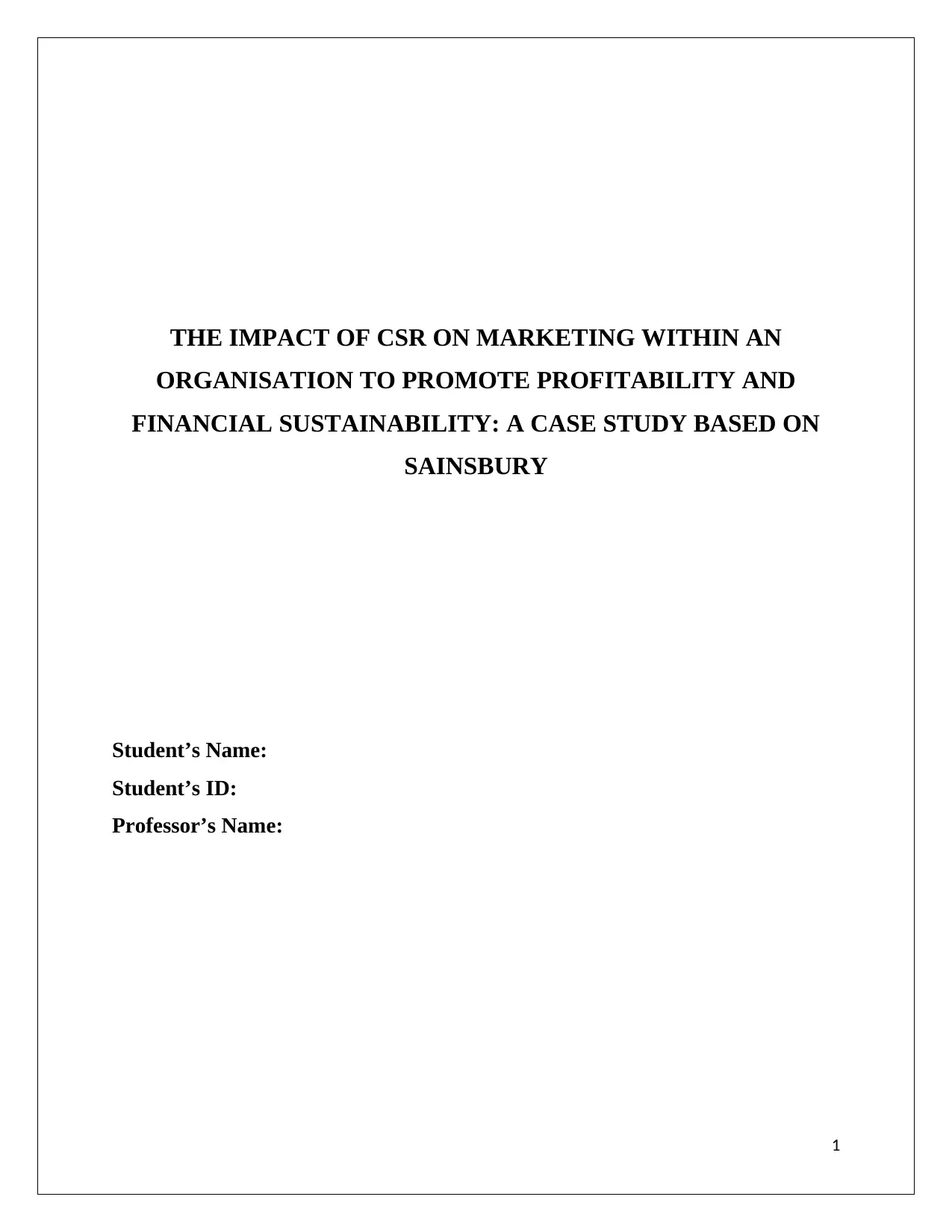
THE IMPACT OF CSR ON MARKETING WITHIN AN
ORGANISATION TO PROMOTE PROFITABILITY AND
FINANCIAL SUSTAINABILITY: A CASE STUDY BASED ON
SAINSBURY
Student’s Name:
Student’s ID:
Professor’s Name:
1
ORGANISATION TO PROMOTE PROFITABILITY AND
FINANCIAL SUSTAINABILITY: A CASE STUDY BASED ON
SAINSBURY
Student’s Name:
Student’s ID:
Professor’s Name:
1
Paraphrase This Document
Need a fresh take? Get an instant paraphrase of this document with our AI Paraphraser
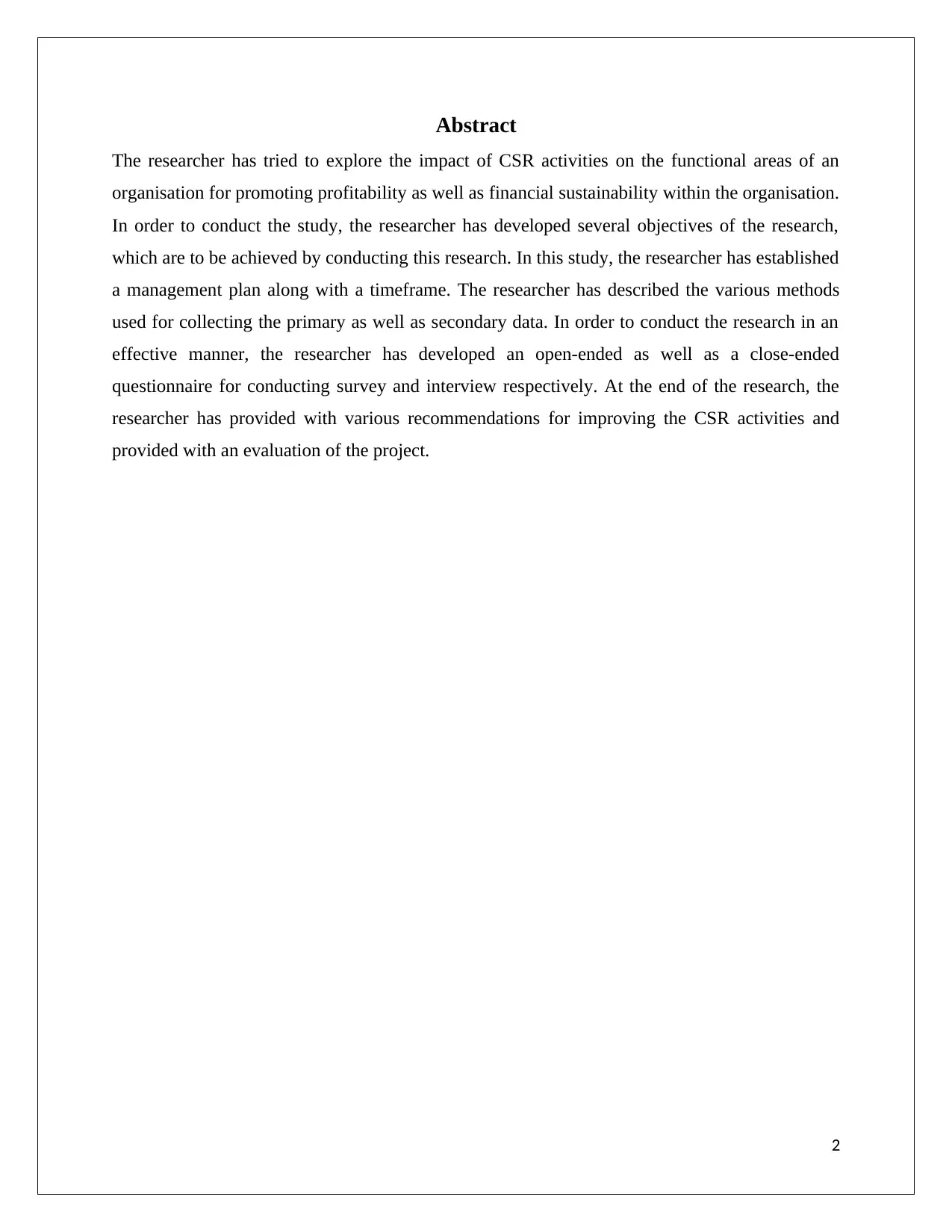
Abstract
The researcher has tried to explore the impact of CSR activities on the functional areas of an
organisation for promoting profitability as well as financial sustainability within the organisation.
In order to conduct the study, the researcher has developed several objectives of the research,
which are to be achieved by conducting this research. In this study, the researcher has established
a management plan along with a timeframe. The researcher has described the various methods
used for collecting the primary as well as secondary data. In order to conduct the research in an
effective manner, the researcher has developed an open-ended as well as a close-ended
questionnaire for conducting survey and interview respectively. At the end of the research, the
researcher has provided with various recommendations for improving the CSR activities and
provided with an evaluation of the project.
2
The researcher has tried to explore the impact of CSR activities on the functional areas of an
organisation for promoting profitability as well as financial sustainability within the organisation.
In order to conduct the study, the researcher has developed several objectives of the research,
which are to be achieved by conducting this research. In this study, the researcher has established
a management plan along with a timeframe. The researcher has described the various methods
used for collecting the primary as well as secondary data. In order to conduct the research in an
effective manner, the researcher has developed an open-ended as well as a close-ended
questionnaire for conducting survey and interview respectively. At the end of the research, the
researcher has provided with various recommendations for improving the CSR activities and
provided with an evaluation of the project.
2
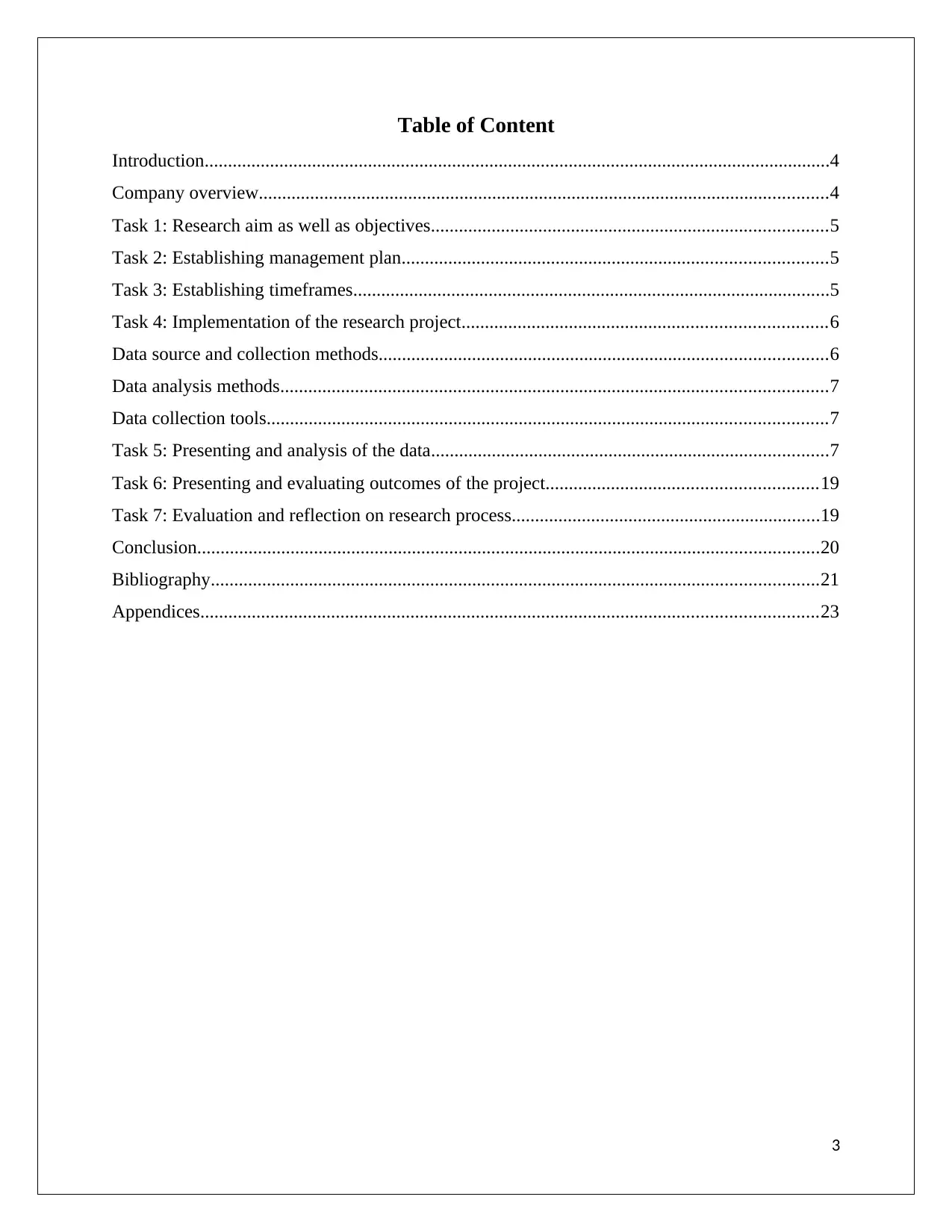
Table of Content
Introduction......................................................................................................................................4
Company overview..........................................................................................................................4
Task 1: Research aim as well as objectives.....................................................................................5
Task 2: Establishing management plan...........................................................................................5
Task 3: Establishing timeframes......................................................................................................5
Task 4: Implementation of the research project..............................................................................6
Data source and collection methods................................................................................................6
Data analysis methods.....................................................................................................................7
Data collection tools........................................................................................................................7
Task 5: Presenting and analysis of the data.....................................................................................7
Task 6: Presenting and evaluating outcomes of the project..........................................................19
Task 7: Evaluation and reflection on research process..................................................................19
Conclusion.....................................................................................................................................20
Bibliography..................................................................................................................................21
Appendices....................................................................................................................................23
3
Introduction......................................................................................................................................4
Company overview..........................................................................................................................4
Task 1: Research aim as well as objectives.....................................................................................5
Task 2: Establishing management plan...........................................................................................5
Task 3: Establishing timeframes......................................................................................................5
Task 4: Implementation of the research project..............................................................................6
Data source and collection methods................................................................................................6
Data analysis methods.....................................................................................................................7
Data collection tools........................................................................................................................7
Task 5: Presenting and analysis of the data.....................................................................................7
Task 6: Presenting and evaluating outcomes of the project..........................................................19
Task 7: Evaluation and reflection on research process..................................................................19
Conclusion.....................................................................................................................................20
Bibliography..................................................................................................................................21
Appendices....................................................................................................................................23
3
⊘ This is a preview!⊘
Do you want full access?
Subscribe today to unlock all pages.

Trusted by 1+ million students worldwide
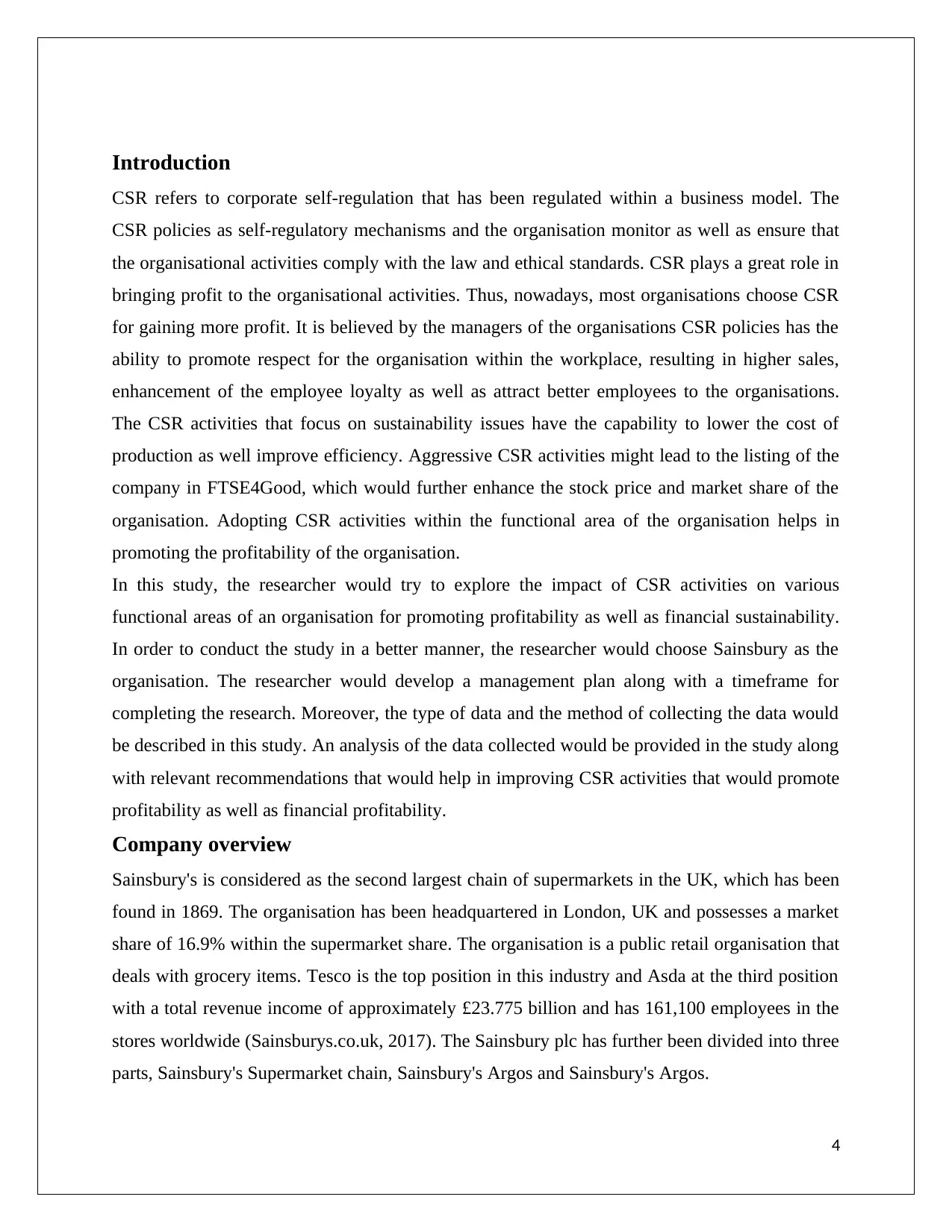
Introduction
CSR refers to corporate self-regulation that has been regulated within a business model. The
CSR policies as self-regulatory mechanisms and the organisation monitor as well as ensure that
the organisational activities comply with the law and ethical standards. CSR plays a great role in
bringing profit to the organisational activities. Thus, nowadays, most organisations choose CSR
for gaining more profit. It is believed by the managers of the organisations CSR policies has the
ability to promote respect for the organisation within the workplace, resulting in higher sales,
enhancement of the employee loyalty as well as attract better employees to the organisations.
The CSR activities that focus on sustainability issues have the capability to lower the cost of
production as well improve efficiency. Aggressive CSR activities might lead to the listing of the
company in FTSE4Good, which would further enhance the stock price and market share of the
organisation. Adopting CSR activities within the functional area of the organisation helps in
promoting the profitability of the organisation.
In this study, the researcher would try to explore the impact of CSR activities on various
functional areas of an organisation for promoting profitability as well as financial sustainability.
In order to conduct the study in a better manner, the researcher would choose Sainsbury as the
organisation. The researcher would develop a management plan along with a timeframe for
completing the research. Moreover, the type of data and the method of collecting the data would
be described in this study. An analysis of the data collected would be provided in the study along
with relevant recommendations that would help in improving CSR activities that would promote
profitability as well as financial profitability.
Company overview
Sainsbury's is considered as the second largest chain of supermarkets in the UK, which has been
found in 1869. The organisation has been headquartered in London, UK and possesses a market
share of 16.9% within the supermarket share. The organisation is a public retail organisation that
deals with grocery items. Tesco is the top position in this industry and Asda at the third position
with a total revenue income of approximately £23.775 billion and has 161,100 employees in the
stores worldwide (Sainsburys.co.uk, 2017). The Sainsbury plc has further been divided into three
parts, Sainsbury's Supermarket chain, Sainsbury's Argos and Sainsbury's Argos.
4
CSR refers to corporate self-regulation that has been regulated within a business model. The
CSR policies as self-regulatory mechanisms and the organisation monitor as well as ensure that
the organisational activities comply with the law and ethical standards. CSR plays a great role in
bringing profit to the organisational activities. Thus, nowadays, most organisations choose CSR
for gaining more profit. It is believed by the managers of the organisations CSR policies has the
ability to promote respect for the organisation within the workplace, resulting in higher sales,
enhancement of the employee loyalty as well as attract better employees to the organisations.
The CSR activities that focus on sustainability issues have the capability to lower the cost of
production as well improve efficiency. Aggressive CSR activities might lead to the listing of the
company in FTSE4Good, which would further enhance the stock price and market share of the
organisation. Adopting CSR activities within the functional area of the organisation helps in
promoting the profitability of the organisation.
In this study, the researcher would try to explore the impact of CSR activities on various
functional areas of an organisation for promoting profitability as well as financial sustainability.
In order to conduct the study in a better manner, the researcher would choose Sainsbury as the
organisation. The researcher would develop a management plan along with a timeframe for
completing the research. Moreover, the type of data and the method of collecting the data would
be described in this study. An analysis of the data collected would be provided in the study along
with relevant recommendations that would help in improving CSR activities that would promote
profitability as well as financial profitability.
Company overview
Sainsbury's is considered as the second largest chain of supermarkets in the UK, which has been
found in 1869. The organisation has been headquartered in London, UK and possesses a market
share of 16.9% within the supermarket share. The organisation is a public retail organisation that
deals with grocery items. Tesco is the top position in this industry and Asda at the third position
with a total revenue income of approximately £23.775 billion and has 161,100 employees in the
stores worldwide (Sainsburys.co.uk, 2017). The Sainsbury plc has further been divided into three
parts, Sainsbury's Supermarket chain, Sainsbury's Argos and Sainsbury's Argos.
4
Paraphrase This Document
Need a fresh take? Get an instant paraphrase of this document with our AI Paraphraser
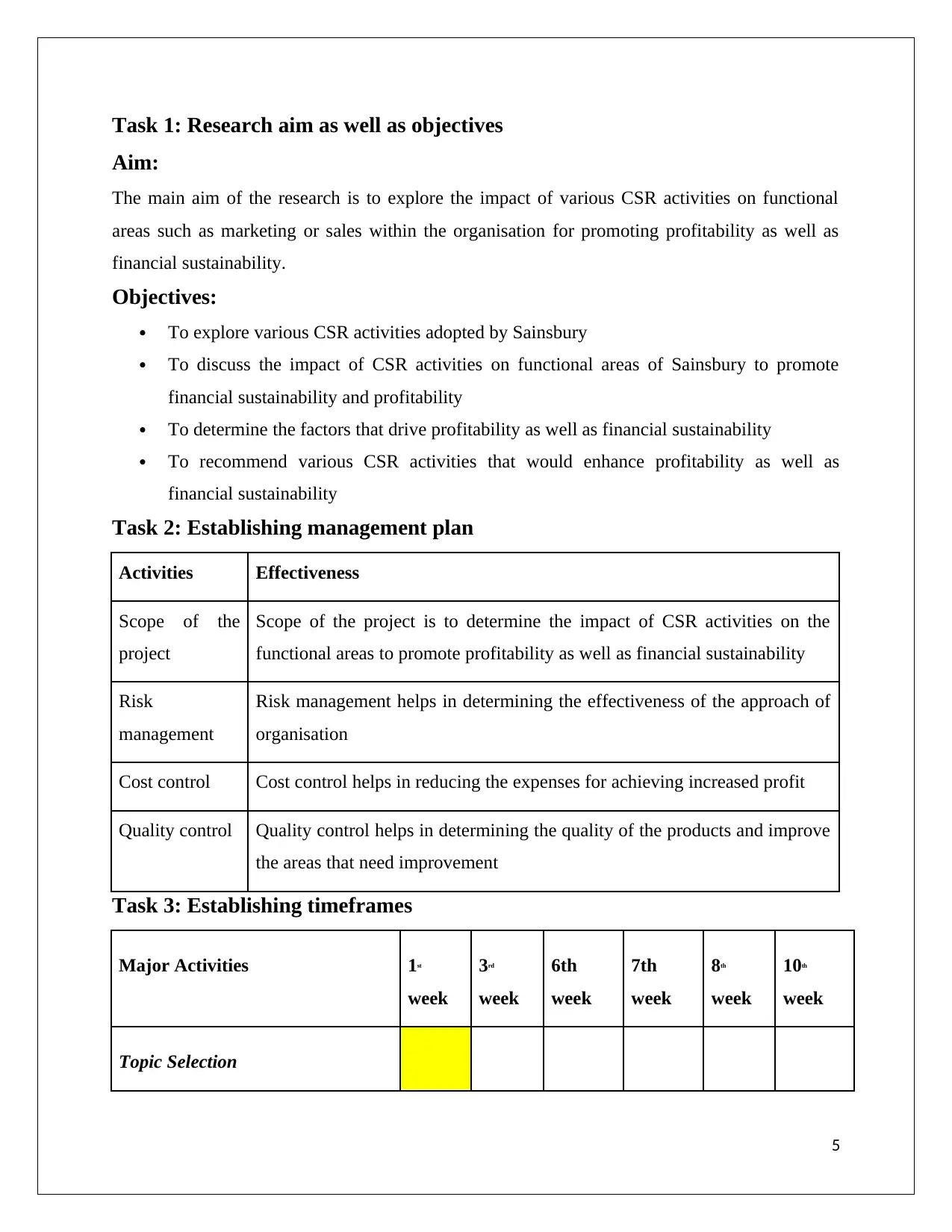
Task 1: Research aim as well as objectives
Aim:
The main aim of the research is to explore the impact of various CSR activities on functional
areas such as marketing or sales within the organisation for promoting profitability as well as
financial sustainability.
Objectives:
To explore various CSR activities adopted by Sainsbury
To discuss the impact of CSR activities on functional areas of Sainsbury to promote
financial sustainability and profitability
To determine the factors that drive profitability as well as financial sustainability
To recommend various CSR activities that would enhance profitability as well as
financial sustainability
Task 2: Establishing management plan
Activities Effectiveness
Scope of the
project
Scope of the project is to determine the impact of CSR activities on the
functional areas to promote profitability as well as financial sustainability
Risk
management
Risk management helps in determining the effectiveness of the approach of
organisation
Cost control Cost control helps in reducing the expenses for achieving increased profit
Quality control Quality control helps in determining the quality of the products and improve
the areas that need improvement
Task 3: Establishing timeframes
Major Activities 1st
week
3rd
week
6th
week
7th
week
8th
week
10th
week
Topic Selection
5
Aim:
The main aim of the research is to explore the impact of various CSR activities on functional
areas such as marketing or sales within the organisation for promoting profitability as well as
financial sustainability.
Objectives:
To explore various CSR activities adopted by Sainsbury
To discuss the impact of CSR activities on functional areas of Sainsbury to promote
financial sustainability and profitability
To determine the factors that drive profitability as well as financial sustainability
To recommend various CSR activities that would enhance profitability as well as
financial sustainability
Task 2: Establishing management plan
Activities Effectiveness
Scope of the
project
Scope of the project is to determine the impact of CSR activities on the
functional areas to promote profitability as well as financial sustainability
Risk
management
Risk management helps in determining the effectiveness of the approach of
organisation
Cost control Cost control helps in reducing the expenses for achieving increased profit
Quality control Quality control helps in determining the quality of the products and improve
the areas that need improvement
Task 3: Establishing timeframes
Major Activities 1st
week
3rd
week
6th
week
7th
week
8th
week
10th
week
Topic Selection
5
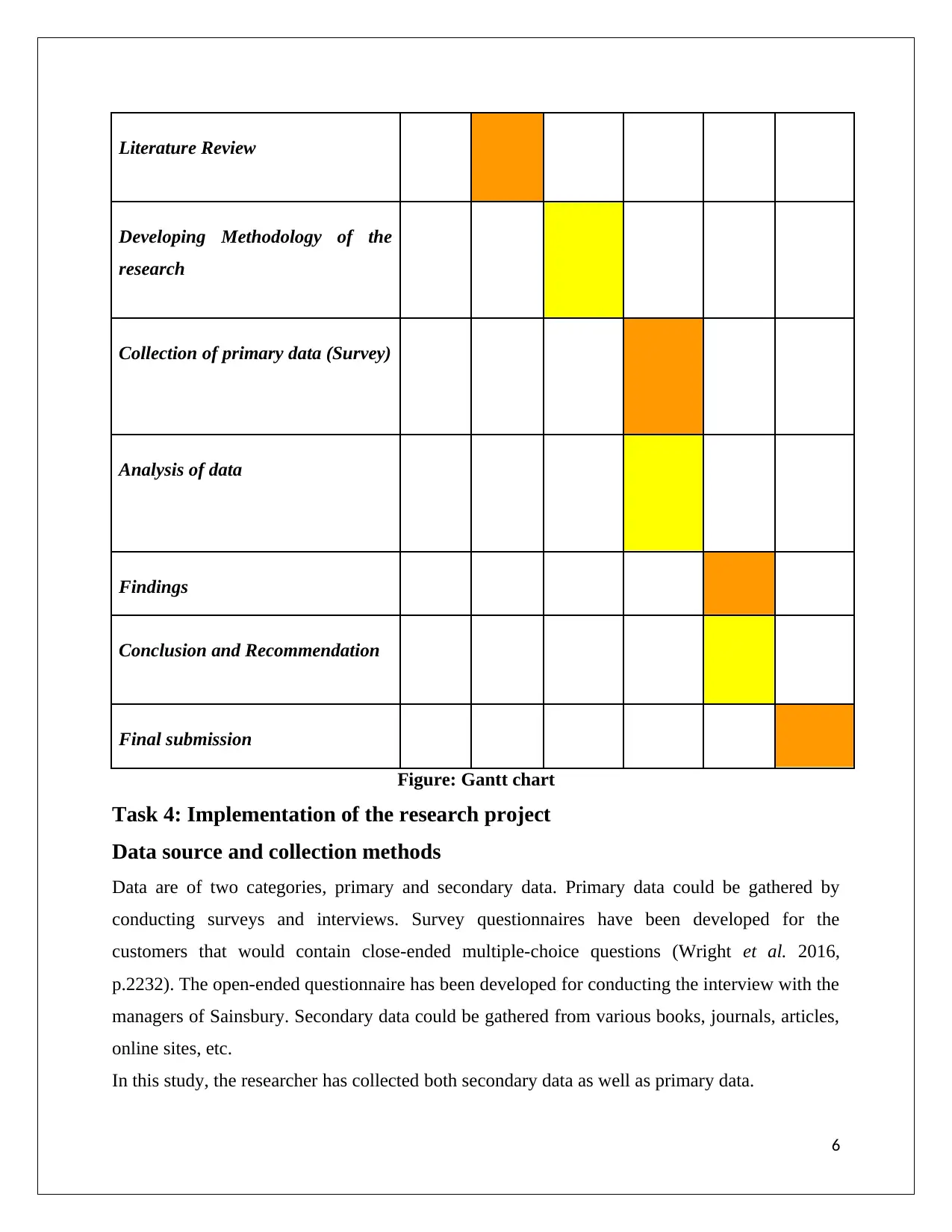
Literature Review
Developing Methodology of the
research
Collection of primary data (Survey)
Analysis of data
Findings
Conclusion and Recommendation
Final submission
Figure: Gantt chart
Task 4: Implementation of the research project
Data source and collection methods
Data are of two categories, primary and secondary data. Primary data could be gathered by
conducting surveys and interviews. Survey questionnaires have been developed for the
customers that would contain close-ended multiple-choice questions (Wright et al. 2016,
p.2232). The open-ended questionnaire has been developed for conducting the interview with the
managers of Sainsbury. Secondary data could be gathered from various books, journals, articles,
online sites, etc.
In this study, the researcher has collected both secondary data as well as primary data.
6
Developing Methodology of the
research
Collection of primary data (Survey)
Analysis of data
Findings
Conclusion and Recommendation
Final submission
Figure: Gantt chart
Task 4: Implementation of the research project
Data source and collection methods
Data are of two categories, primary and secondary data. Primary data could be gathered by
conducting surveys and interviews. Survey questionnaires have been developed for the
customers that would contain close-ended multiple-choice questions (Wright et al. 2016,
p.2232). The open-ended questionnaire has been developed for conducting the interview with the
managers of Sainsbury. Secondary data could be gathered from various books, journals, articles,
online sites, etc.
In this study, the researcher has collected both secondary data as well as primary data.
6
⊘ This is a preview!⊘
Do you want full access?
Subscribe today to unlock all pages.

Trusted by 1+ million students worldwide
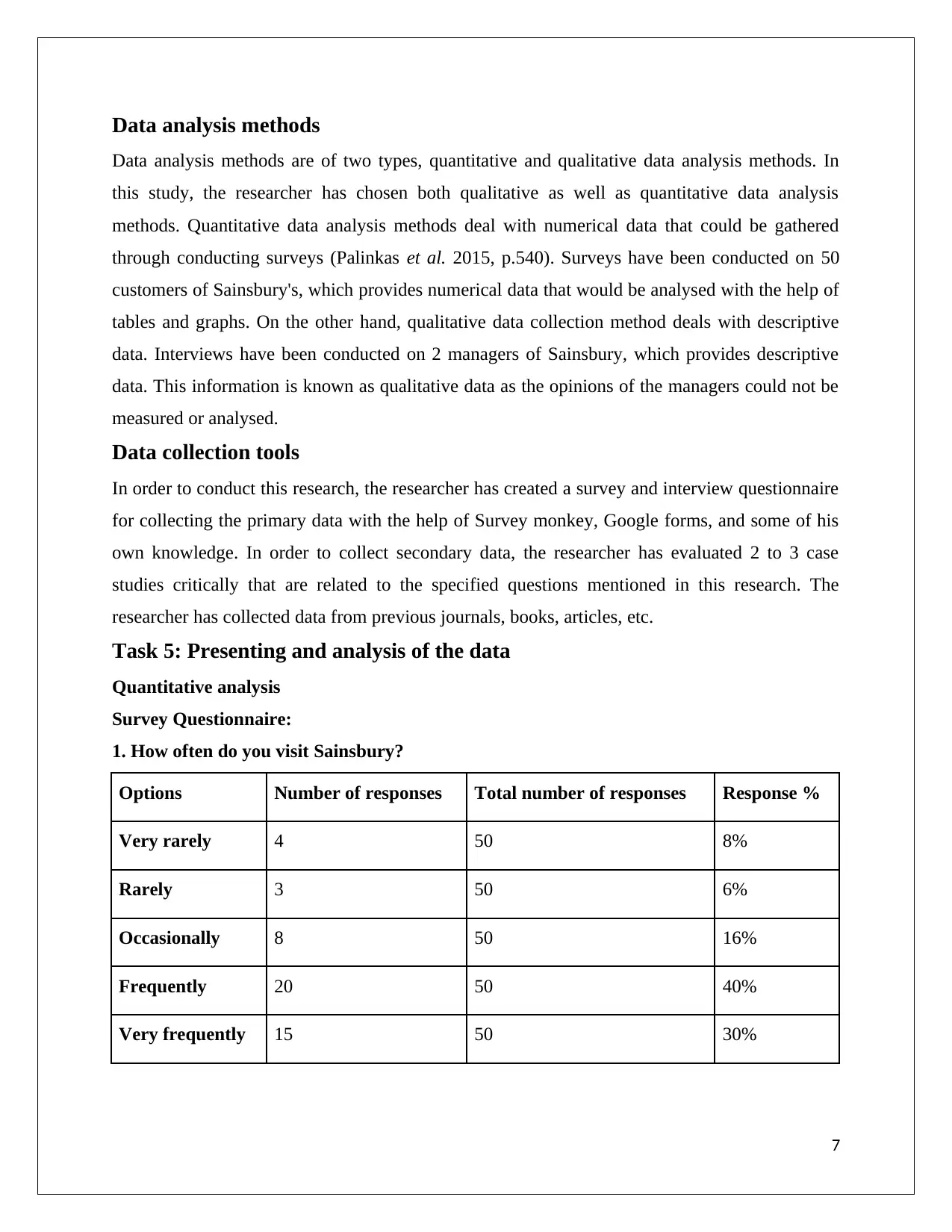
Data analysis methods
Data analysis methods are of two types, quantitative and qualitative data analysis methods. In
this study, the researcher has chosen both qualitative as well as quantitative data analysis
methods. Quantitative data analysis methods deal with numerical data that could be gathered
through conducting surveys (Palinkas et al. 2015, p.540). Surveys have been conducted on 50
customers of Sainsbury's, which provides numerical data that would be analysed with the help of
tables and graphs. On the other hand, qualitative data collection method deals with descriptive
data. Interviews have been conducted on 2 managers of Sainsbury, which provides descriptive
data. This information is known as qualitative data as the opinions of the managers could not be
measured or analysed.
Data collection tools
In order to conduct this research, the researcher has created a survey and interview questionnaire
for collecting the primary data with the help of Survey monkey, Google forms, and some of his
own knowledge. In order to collect secondary data, the researcher has evaluated 2 to 3 case
studies critically that are related to the specified questions mentioned in this research. The
researcher has collected data from previous journals, books, articles, etc.
Task 5: Presenting and analysis of the data
Quantitative analysis
Survey Questionnaire:
1. How often do you visit Sainsbury?
Options Number of responses Total number of responses Response %
Very rarely 4 50 8%
Rarely 3 50 6%
Occasionally 8 50 16%
Frequently 20 50 40%
Very frequently 15 50 30%
7
Data analysis methods are of two types, quantitative and qualitative data analysis methods. In
this study, the researcher has chosen both qualitative as well as quantitative data analysis
methods. Quantitative data analysis methods deal with numerical data that could be gathered
through conducting surveys (Palinkas et al. 2015, p.540). Surveys have been conducted on 50
customers of Sainsbury's, which provides numerical data that would be analysed with the help of
tables and graphs. On the other hand, qualitative data collection method deals with descriptive
data. Interviews have been conducted on 2 managers of Sainsbury, which provides descriptive
data. This information is known as qualitative data as the opinions of the managers could not be
measured or analysed.
Data collection tools
In order to conduct this research, the researcher has created a survey and interview questionnaire
for collecting the primary data with the help of Survey monkey, Google forms, and some of his
own knowledge. In order to collect secondary data, the researcher has evaluated 2 to 3 case
studies critically that are related to the specified questions mentioned in this research. The
researcher has collected data from previous journals, books, articles, etc.
Task 5: Presenting and analysis of the data
Quantitative analysis
Survey Questionnaire:
1. How often do you visit Sainsbury?
Options Number of responses Total number of responses Response %
Very rarely 4 50 8%
Rarely 3 50 6%
Occasionally 8 50 16%
Frequently 20 50 40%
Very frequently 15 50 30%
7
Paraphrase This Document
Need a fresh take? Get an instant paraphrase of this document with our AI Paraphraser
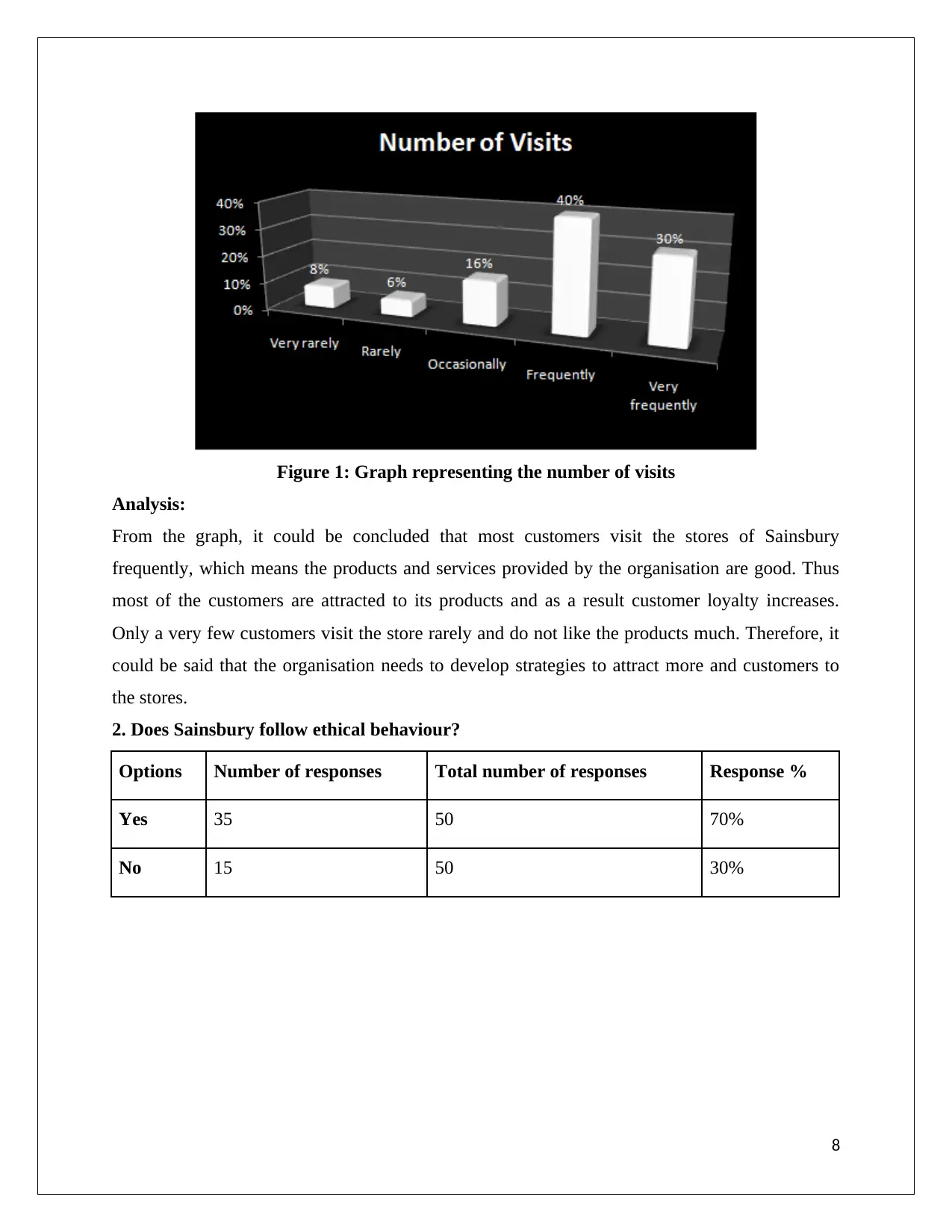
Figure 1: Graph representing the number of visits
Analysis:
From the graph, it could be concluded that most customers visit the stores of Sainsbury
frequently, which means the products and services provided by the organisation are good. Thus
most of the customers are attracted to its products and as a result customer loyalty increases.
Only a very few customers visit the store rarely and do not like the products much. Therefore, it
could be said that the organisation needs to develop strategies to attract more and customers to
the stores.
2. Does Sainsbury follow ethical behaviour?
Options Number of responses Total number of responses Response %
Yes 35 50 70%
No 15 50 30%
8
Analysis:
From the graph, it could be concluded that most customers visit the stores of Sainsbury
frequently, which means the products and services provided by the organisation are good. Thus
most of the customers are attracted to its products and as a result customer loyalty increases.
Only a very few customers visit the store rarely and do not like the products much. Therefore, it
could be said that the organisation needs to develop strategies to attract more and customers to
the stores.
2. Does Sainsbury follow ethical behaviour?
Options Number of responses Total number of responses Response %
Yes 35 50 70%
No 15 50 30%
8
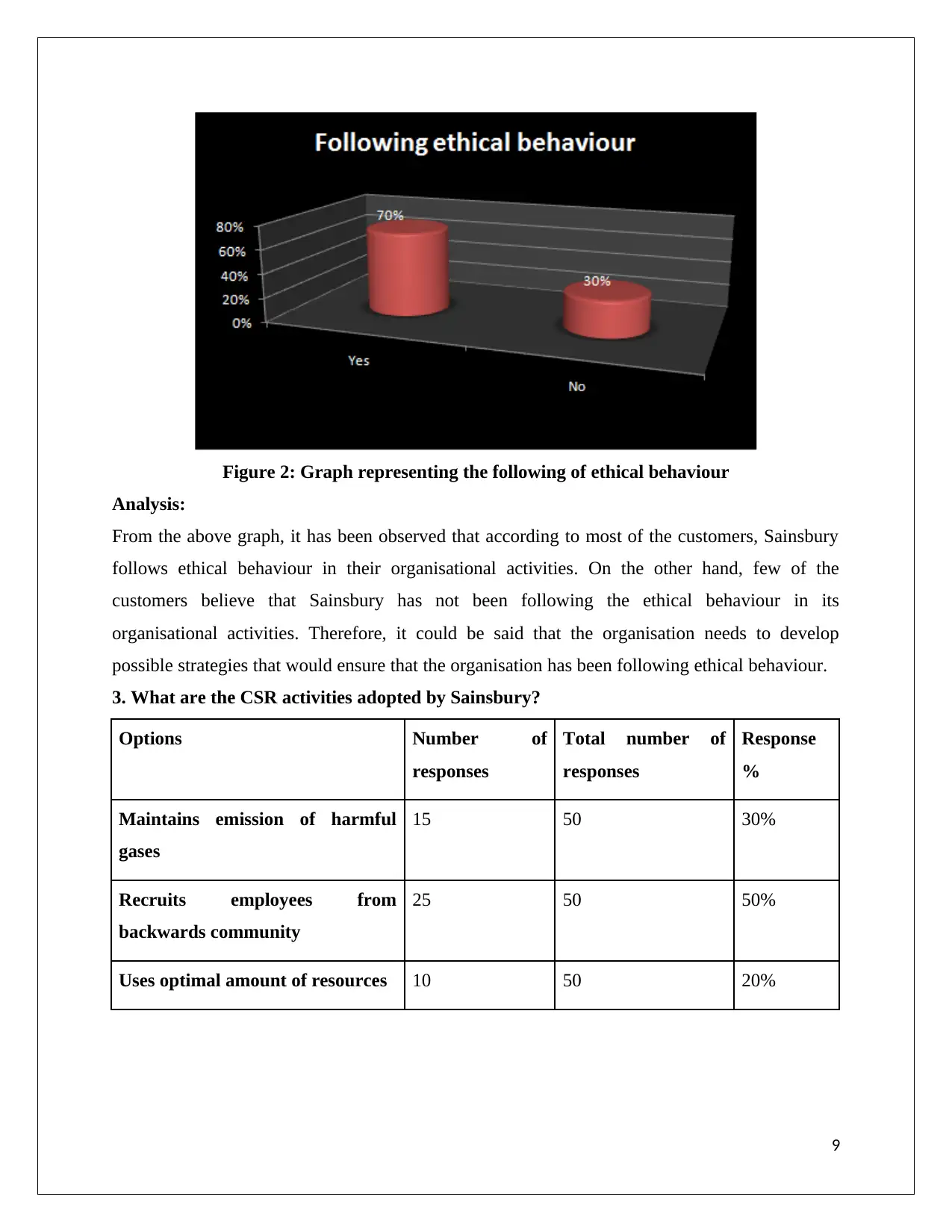
Figure 2: Graph representing the following of ethical behaviour
Analysis:
From the above graph, it has been observed that according to most of the customers, Sainsbury
follows ethical behaviour in their organisational activities. On the other hand, few of the
customers believe that Sainsbury has not been following the ethical behaviour in its
organisational activities. Therefore, it could be said that the organisation needs to develop
possible strategies that would ensure that the organisation has been following ethical behaviour.
3. What are the CSR activities adopted by Sainsbury?
Options Number of
responses
Total number of
responses
Response
%
Maintains emission of harmful
gases
15 50 30%
Recruits employees from
backwards community
25 50 50%
Uses optimal amount of resources 10 50 20%
9
Analysis:
From the above graph, it has been observed that according to most of the customers, Sainsbury
follows ethical behaviour in their organisational activities. On the other hand, few of the
customers believe that Sainsbury has not been following the ethical behaviour in its
organisational activities. Therefore, it could be said that the organisation needs to develop
possible strategies that would ensure that the organisation has been following ethical behaviour.
3. What are the CSR activities adopted by Sainsbury?
Options Number of
responses
Total number of
responses
Response
%
Maintains emission of harmful
gases
15 50 30%
Recruits employees from
backwards community
25 50 50%
Uses optimal amount of resources 10 50 20%
9
⊘ This is a preview!⊘
Do you want full access?
Subscribe today to unlock all pages.

Trusted by 1+ million students worldwide
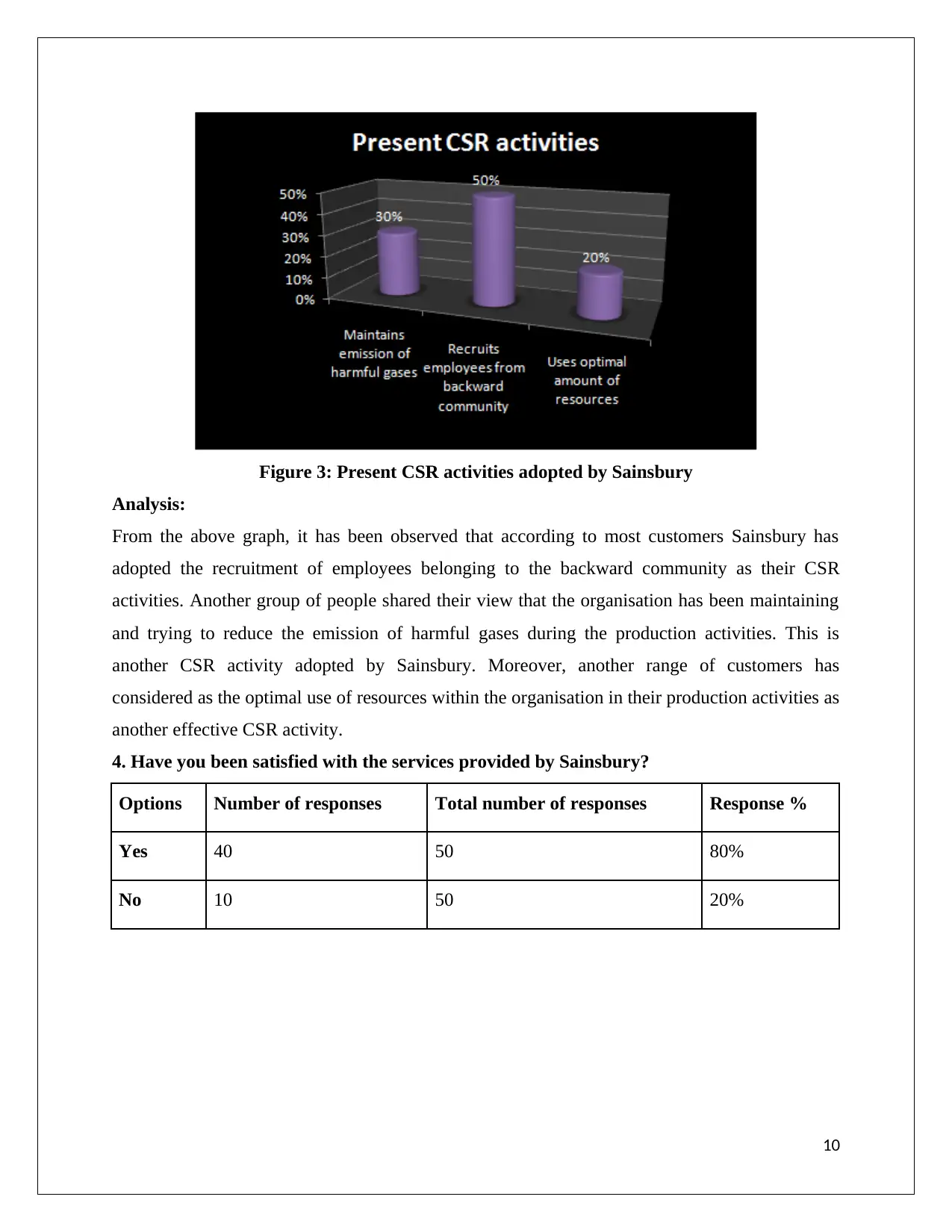
Figure 3: Present CSR activities adopted by Sainsbury
Analysis:
From the above graph, it has been observed that according to most customers Sainsbury has
adopted the recruitment of employees belonging to the backward community as their CSR
activities. Another group of people shared their view that the organisation has been maintaining
and trying to reduce the emission of harmful gases during the production activities. This is
another CSR activity adopted by Sainsbury. Moreover, another range of customers has
considered as the optimal use of resources within the organisation in their production activities as
another effective CSR activity.
4. Have you been satisfied with the services provided by Sainsbury?
Options Number of responses Total number of responses Response %
Yes 40 50 80%
No 10 50 20%
10
Analysis:
From the above graph, it has been observed that according to most customers Sainsbury has
adopted the recruitment of employees belonging to the backward community as their CSR
activities. Another group of people shared their view that the organisation has been maintaining
and trying to reduce the emission of harmful gases during the production activities. This is
another CSR activity adopted by Sainsbury. Moreover, another range of customers has
considered as the optimal use of resources within the organisation in their production activities as
another effective CSR activity.
4. Have you been satisfied with the services provided by Sainsbury?
Options Number of responses Total number of responses Response %
Yes 40 50 80%
No 10 50 20%
10
Paraphrase This Document
Need a fresh take? Get an instant paraphrase of this document with our AI Paraphraser
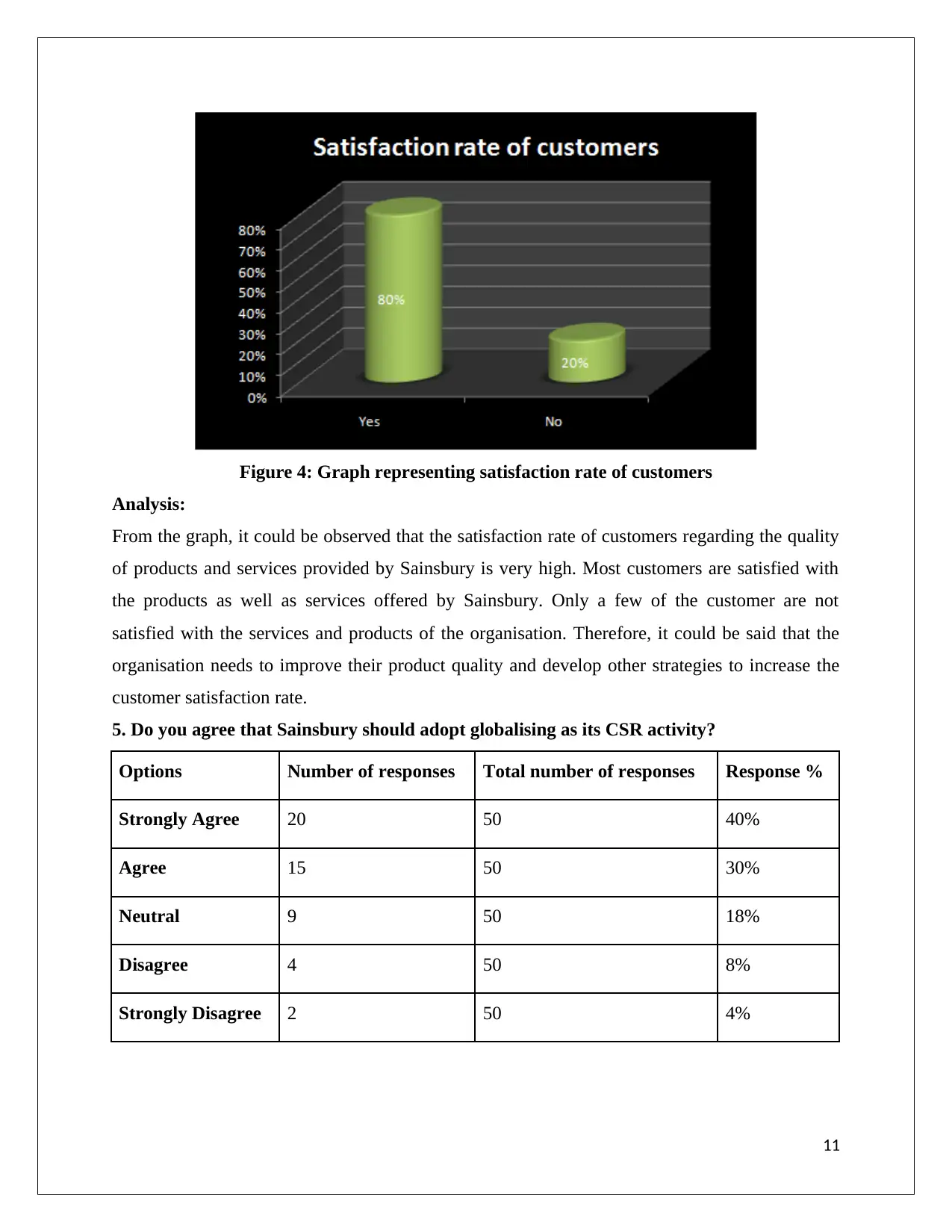
Figure 4: Graph representing satisfaction rate of customers
Analysis:
From the graph, it could be observed that the satisfaction rate of customers regarding the quality
of products and services provided by Sainsbury is very high. Most customers are satisfied with
the products as well as services offered by Sainsbury. Only a few of the customer are not
satisfied with the services and products of the organisation. Therefore, it could be said that the
organisation needs to improve their product quality and develop other strategies to increase the
customer satisfaction rate.
5. Do you agree that Sainsbury should adopt globalising as its CSR activity?
Options Number of responses Total number of responses Response %
Strongly Agree 20 50 40%
Agree 15 50 30%
Neutral 9 50 18%
Disagree 4 50 8%
Strongly Disagree 2 50 4%
11
Analysis:
From the graph, it could be observed that the satisfaction rate of customers regarding the quality
of products and services provided by Sainsbury is very high. Most customers are satisfied with
the products as well as services offered by Sainsbury. Only a few of the customer are not
satisfied with the services and products of the organisation. Therefore, it could be said that the
organisation needs to improve their product quality and develop other strategies to increase the
customer satisfaction rate.
5. Do you agree that Sainsbury should adopt globalising as its CSR activity?
Options Number of responses Total number of responses Response %
Strongly Agree 20 50 40%
Agree 15 50 30%
Neutral 9 50 18%
Disagree 4 50 8%
Strongly Disagree 2 50 4%
11
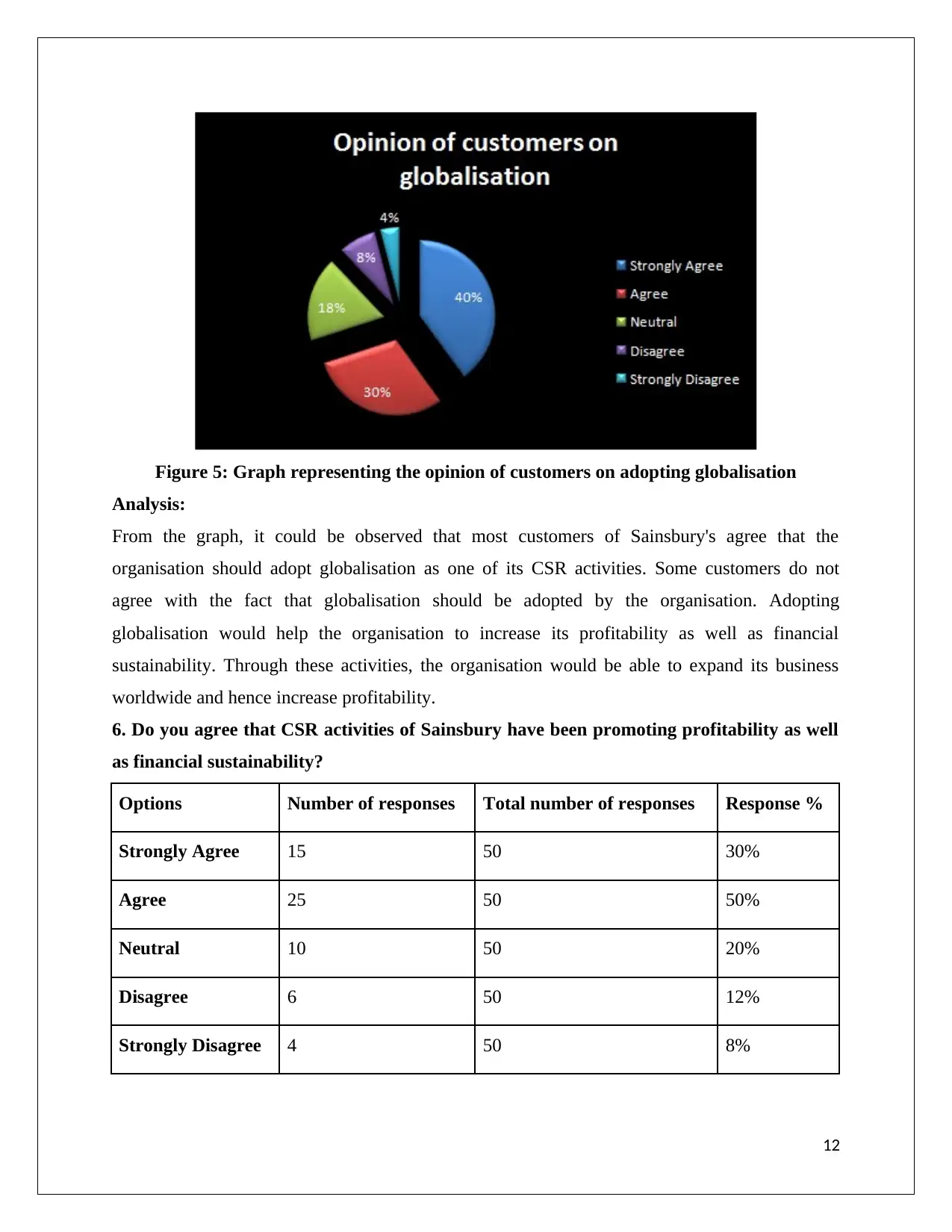
Figure 5: Graph representing the opinion of customers on adopting globalisation
Analysis:
From the graph, it could be observed that most customers of Sainsbury's agree that the
organisation should adopt globalisation as one of its CSR activities. Some customers do not
agree with the fact that globalisation should be adopted by the organisation. Adopting
globalisation would help the organisation to increase its profitability as well as financial
sustainability. Through these activities, the organisation would be able to expand its business
worldwide and hence increase profitability.
6. Do you agree that CSR activities of Sainsbury have been promoting profitability as well
as financial sustainability?
Options Number of responses Total number of responses Response %
Strongly Agree 15 50 30%
Agree 25 50 50%
Neutral 10 50 20%
Disagree 6 50 12%
Strongly Disagree 4 50 8%
12
Analysis:
From the graph, it could be observed that most customers of Sainsbury's agree that the
organisation should adopt globalisation as one of its CSR activities. Some customers do not
agree with the fact that globalisation should be adopted by the organisation. Adopting
globalisation would help the organisation to increase its profitability as well as financial
sustainability. Through these activities, the organisation would be able to expand its business
worldwide and hence increase profitability.
6. Do you agree that CSR activities of Sainsbury have been promoting profitability as well
as financial sustainability?
Options Number of responses Total number of responses Response %
Strongly Agree 15 50 30%
Agree 25 50 50%
Neutral 10 50 20%
Disagree 6 50 12%
Strongly Disagree 4 50 8%
12
⊘ This is a preview!⊘
Do you want full access?
Subscribe today to unlock all pages.

Trusted by 1+ million students worldwide
1 out of 25
Related Documents
Your All-in-One AI-Powered Toolkit for Academic Success.
+13062052269
info@desklib.com
Available 24*7 on WhatsApp / Email
![[object Object]](/_next/static/media/star-bottom.7253800d.svg)
Unlock your academic potential
Copyright © 2020–2025 A2Z Services. All Rights Reserved. Developed and managed by ZUCOL.





